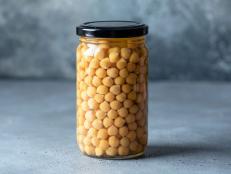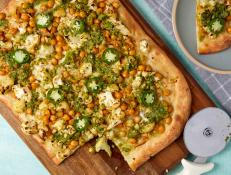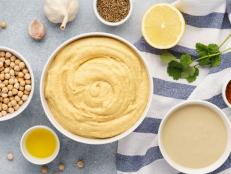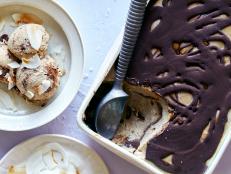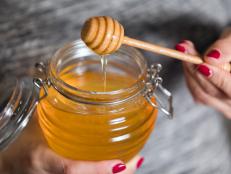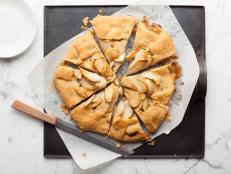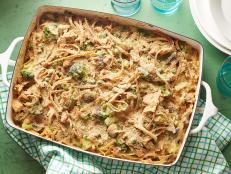Are Chickpeas Healthy?
Because the hummus craze is real.

For years, you’ve likely been tossing chickpeas into your salad or even your pasta. But now that the legumes are banned on the crazy-popular Whole30 and Keto diets — not to mention appearing in smoothies and covered in chocolate — you might be wondering: are chickpeas healthy or not? We chatted with culinary nutritionist experts to find out.
How healthy are chickpeas?
Let’s start with the basics. Chickpeas as a solo food are packed with nutrition. A cup of cooked chickpeas, for instance, contains 269 calories — and offers an excellent amount of protein (15 grams) and fiber (13 grams), helping to keep you fuller for longer and prevent that “hangry” feeling. They’re also loaded with vitamins and minerals, including iron, magnesium, potassium, zinc, folate and vitamin A.
Chickpeas will add extra nutrition to dishes you typically eat. “They work well in cauliflower mashed potatoes, in tahini for a quick hummus and added to soup,” notes Tracee Yablon Brenner, RD, a culinary nutritionist in Nyack, NY. You can also blend chickpeas into smoothies for an extra boost of protein and fiber.
Should you go with canned or dried?
“The major nutritional difference between dried and canned chickpeas is their sodium content, with canned beans averaging between 300 to 400 milligrams sodium per half-cup serving, depending on the brand,” says Rachel Begun, MS, RDN, a culinary nutritionist and co-founder of the The Modern Loaf in Los Angeles. “Dried chickpeas are essentially sodium-free.” They naturally contain only a very small amount of sodium, 11 milligrams per cup.
There are workarounds to the sodium content of canned chickpeas. For starters, always rinse and drain your canned chickpeas to remove some of the sodium. And consider purchasing low-sodium canned chickpeas. Cans labeled “no salt added” typically contain a very minimal amount of sodium, about 10 to 30 milligrams per half-cup serving. In addition to the sodium they naturally contain, sometimes other sodium-containing ingredients — such as kombu seaweed, which helps you digest the oligosaccharides in chickpeas — are added to these varieties of chickpeas.
Canned chickpeas are a time saver because cooking up your own batch of dried beans can take hours. “Canned chickpeas don't have to be cooked to add to smoothies,” says Brenner. Lastly, don’t ditch the liquid in canned chickpeas. Called aquafaba, it can be used to make egg-free meringue.
When it comes to cooking dried chickpeas, you’ll want to rinse them, soak them overnight, and then boil or pressure cook them. “Soaking dried chickpeas overnight makes them easier to digest and reduces cooking time,” says Begun. “Also make sure to drain the water that the chickpeas were soaked in and to thoroughly rinse them before cooking. This will also make them easier to digest.”
What about all those packaged chickpeas and fancy chickpea smoothies?
Perhaps your neighborhood smoothie shop has jumped onto the chickpea trend and is featuring hummus smoothies on its menu. Like all smoothies, you’ll want to see what else is in the drink, what the portion size is and how much added sugar it contains. Chickpeas can add satiating protein to a beverage, but if the smoothie contains a lot of added sugar and other high-calorie ingredients, it may not be the best choice.
As for packaged chickpeas, you’ll likely see everything from roasted and flavored chickpeas to dark-chocolate-covered ones in your local grocery store. “The novelty chickpea items such as packaged dry-roasted chickpeas and dark-chocolate-covered ones are a good snack, as they are a source of protein and fiber,” says Brenner. But make sure to read labels. “Like almost all packaged snacks these days, there are healthful and not-so-healthful options for roasted chickpeas snacks,” says Begun. “While rich in fiber, protein, folate and phytonutrients, depending on how they’re flavored or seasoned they may also contain high amounts of added sugars, fat or sodium.” But is eating a small handful of dark-chocolate-covered chickpeas a more nutritious option than eating a giant cupcake? Most definitely yes.
Amy Gorin, MS, RDN, is a registered dietitian nutritionist and owner of Amy Gorin Nutrition in the New York City area. She’s a regular contributor to many publications, including EverydayHealth.com, NBCNews.com, Runner’s World, and more. She also pens a recipe-focused blog, Amy’s Eat List.
Related Content:
























